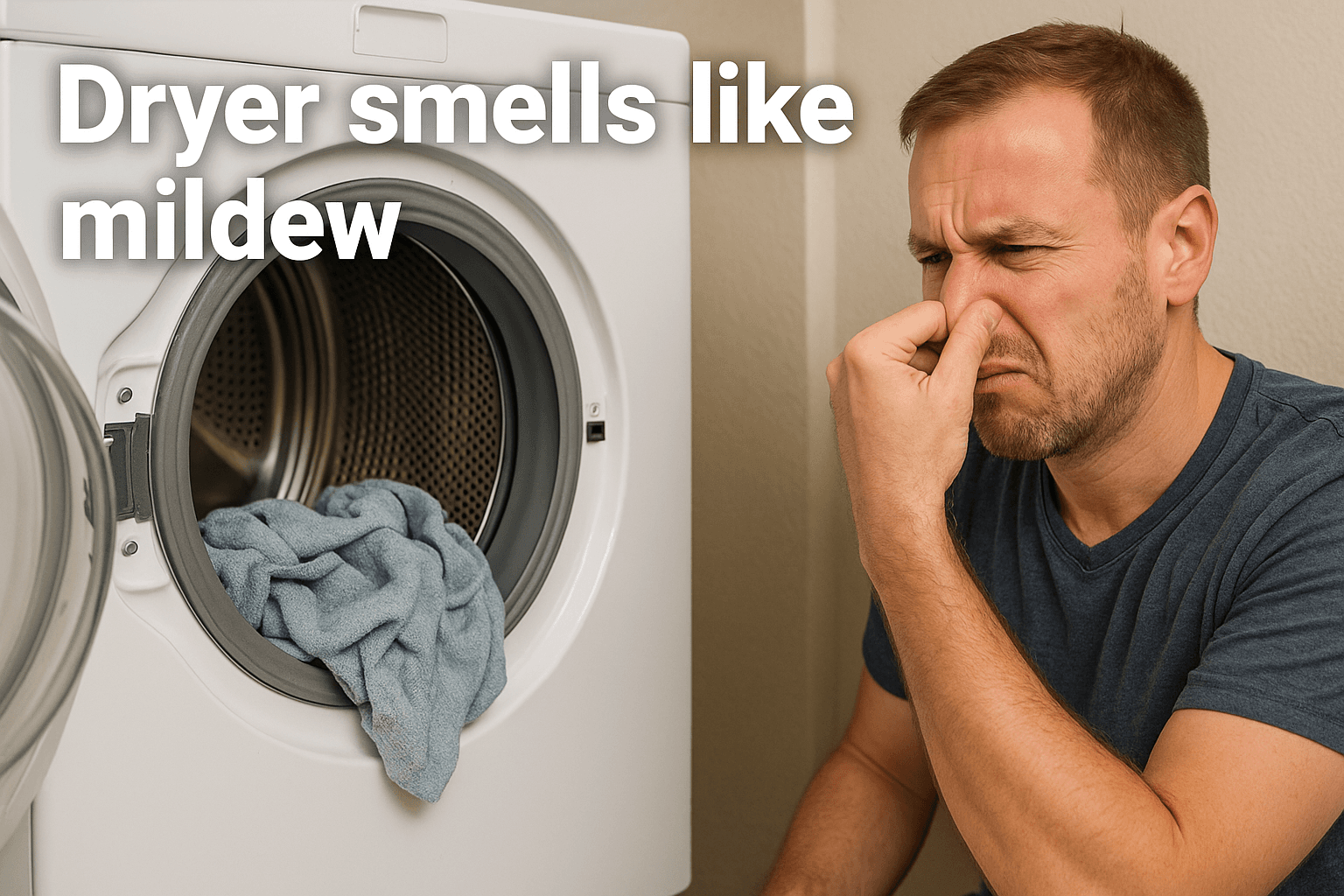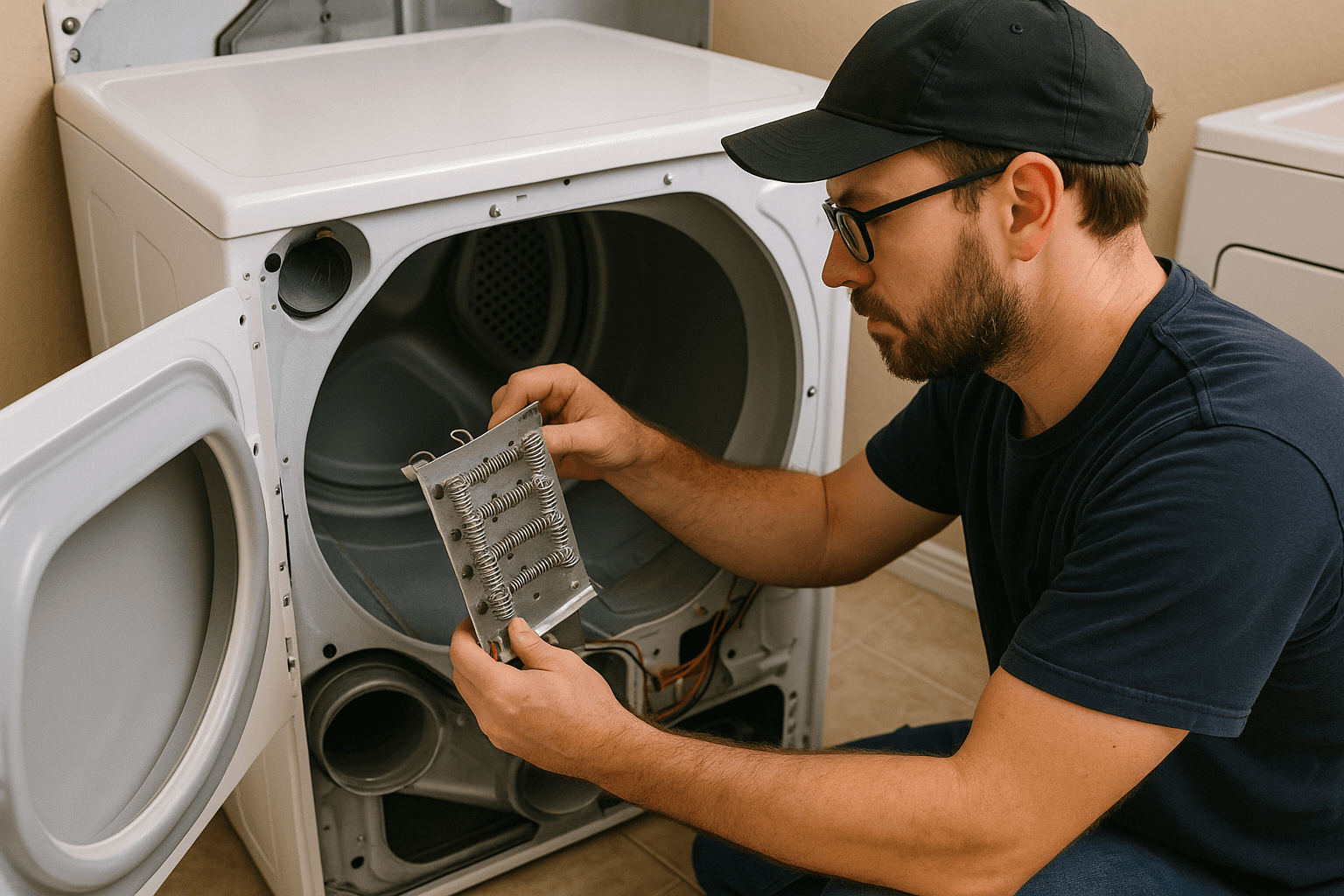Repair help
Why Is My Dryer Leaking Water? 7 Causes and Fixes
AZparts Team
Updated on July 17, 2025
9 min read
Have you noticed dryer leaking water and seen puddles forming on the floor after each use but do not know why it is happening? This is a fairly common issue that is often overlooked yet it can reduce your dryer’s efficiency and even lead to electrical hazards or equipment damage. In this article, AZParts will help you identify 7 common causes of dryer leaking water from blocked ventilation ducts to a faulty condenser tray along with easy step by step solutions you can try at home.

1. Common Causes of Dryer Leaking Water
Blocked Ventilation System
The dryer’s ventilation system is responsible for expelling hot, humid air from the drum to the outside. When the vent hose or exhaust outlet becomes clogged with lint, pet hair, or debris over time, moisture cannot escape efficiently. This leads to condensation inside the dryer or vent pipe, resulting in water leaking onto the floor. In addition to reducing the dryer’s performance, a blocked vent can also increase the risk of overheating and fire.
Inadequate or Damaged Vent Duct Insulation
In areas where there are significant temperature changes such as when the duct passes through the attic or an exterior wall, poorly insulated ducts can cause warm air to condense into water. This water can drip back into the dryer or leak out through small gaps in the duct. This often happens in cold seasons or in places with high humidity. Using high quality insulation and sealing the duct properly can greatly reduce this issue.
Holes or Cracks in the Ventilation Duct
Over time, vent ducts can become worn out, cracked, or punctured due to external impact, rodents, or environmental factors. When this happens, condensed water may leak from the duct and seep into nearby walls, floors, or electronics. This not only damages the surrounding area but also reduces the dryer’s efficiency. Regular inspection and replacement of damaged ducts is important to avoid further problems.

Vent ducts can become worn out causes of dryer leaking water (Source: AZParts)
Defective or Stuck Vent Flap
Outdoor vent flaps are designed to open and close with the airflow from the dryer and to prevent outside air from entering. If the flap gets stuck due to dirt, rust, or improper installation, it may not open when the dryer is running. As a result, steam is trapped inside the duct, leading to condensation and water leakage. A faulty flap also contributes to mold buildup and unpleasant odors in the home.
Condenser Dryer Full or Malfunctioning
A condenser dryer collects moisture in a water tray or tank instead of venting it outside. If the user forgets to empty the tank regularly or the sensor that detects a full tray is faulty, the water may overflow and leak. In addition, if the condenser unit is dirty or damaged, it will not be able to process moisture properly, which can lead to internal leaks. Cleaning the condenser and checking the sensor often will help prevent this.
Dryer Installed Indoors with Poor Venting
In many cases, dryers are installed in closed spaces like laundry rooms or storage areas without proper ventilation. Without an outlet for the humid air, moisture accumulates in the surrounding space, causing condensation on walls, ceilings, or even flowing back into the dryer. Users may mistake this for a leak from the machine itself when in fact the environment is too humid. Installing an effective vent or using a properly maintained condenser dryer can solve this problem.
The Dryer is Not Level
Some dryers have a fixed water tank or condenser unit that must be kept level. If the dryer is placed on an uneven surface, water can spill out easily. In addition, an unbalanced dryer may shake during operation, which can loosen connections or dislodge the tray, leading to leaks. Aside from damaging the machine, this can also create safety hazards such as slippery floors or exposure to electrical components. Always check that the dryer is placed on a flat and stable surface.
2. Less Common Causes of Dryer Leaks
Overloaded Dryer with Wet Clothes
When you put too many wet clothes into the dryer at once, the machine has to work harder to dry all the excess moisture. If the humidity level is too high, the dryer may not be able to handle it effectively, causing steam to build up and condense inside the unit. This moisture can then leak out onto the floor. Overloading can also reduce airflow efficiency, making it harder for steam to escape and resulting in water accumulation. Not only can this cause leaks, but it can also prevent clothes from drying completely or even damage the dryer motor.

When you put too many wet clothes into the dryer at once, the machine has to work harder (Source: AZParts)
Clogged Lint Filter
The lint filter is designed to trap fibers, pet hair, and dust from your clothes during the drying cycle. If it is not cleaned regularly, the filter can become clogged, blocking hot air from flowing out properly. When air cannot escape, steam becomes trapped inside the dryer, condenses into water, and eventually leaks out. In severe cases, a clogged lint filter can cause the dryer to overheat and pose a fire risk due to excess heat buildup.
Defective Door Seal or Gasket
The rubber door seal or gasket in a dryer is designed to prevent steam and moisture from escaping during operation. When the gasket becomes torn, cracked, or loses its elasticity, steam can leak out and condense into water around the door area. This often results in puddles under the machine or damp spots on the floor. Replacing a damaged door gasket is a simple yet highly effective solution to stop this issue.
To ensure long lasting performance, you can find high quality replacement dryer drum felt seals at AZParts, compatible with a wide range of dryer models. Choosing the right part not only helps fix the leak but also restores the efficiency and safety of your dryer.
Burst or Loose Water Supply Hose
Some modern dryers, especially those with automatic condensation features, are connected to a water supply line. If this hose becomes loose, cracked, or bursts due to wear and tear, water can continuously leak during operation. Leaks from the water hose are often mistaken for internal leaks from the dryer itself, making it harder to identify the true source. To avoid this, regularly check the water connection hoses and replace them when necessary.
3. How to Fix a Leaking Dryer (DIY Guide)
Step 1: Check and Clean the Vent
Start by inspecting the entire dryer vent to make sure there are no obstructions caused by lint, pet hair, or built up debris. Use a special brush or a vacuum cleaner to clean the inside of the vent and exhaust openings. A clear ventilation system allows steam to escape efficiently and prevents condensation buildup that leads to leaks. For best results, check and clean the system every 3 to 6 months, especially if you use the dryer frequently.

Check and Clean the Vent (Source: AZParts)
Step 2: Inspect for Duct Damage
Examine the entire length of the vent duct for cracks, holes, or signs of leaks. Also check all the joints to ensure they are not loose, misaligned, or leaking. If you find any damage, replace the duct with a new one or use duct tape as a temporary seal. Keeping the duct intact will help the dryer function properly and prevent water from leaking out.
Step 3: Test the Vent Flap
Go outside to the end of the exhaust vent and inspect the vent flap (also known as the exhaust cover). This flap should automatically open when the dryer is running and close afterward. If it is stuck due to rust, dirt, or insect nests, it should be cleaned or replaced. A smooth working flap allows proper airflow and prevents moisture from being pushed back into the dryer.
Step 4: Level Your Dryer
Use a spirit level to check if the dryer is placed evenly on the floor. If it is tilted or has uneven legs, adjust the feet until the unit is stable and stands upright. A level dryer not only prevents water leakage but also ensures smooth and quiet operation, helping extend the life of the appliance.
Step 5: Empty Water Tray (Condenser Models)
If you are using a condenser dryer, make sure to check and empty the water tank after each drying cycle or when the full tank warning appears on the screen. Sometimes, the water level sensor may malfunction and fail to alert you, so it's a good idea to check manually. Also, clean the water tank and condenser unit regularly to ensure proper water collection and prevent overflow, floor moisture, and mold growth.

Empty the water tank after each cycle or when alerted (Source: AZParts)
4. FAQs About Dryer Leaks
4.1 Can a dryer leak water from underneath?
Yes, a dryer can leak water from underneath if moisture inside the machine cannot escape properly and starts to condense. When too much water builds up, it can collect at the bottom and eventually drip onto the floor.
4.2 Is a leaking dryer dangerous?
Yes, a dryer can leak water from underneath if moisture inside the machine cannot escape properly and starts to condense. When too much water builds up, it can collect at the bottom and eventually drip onto the floor.
A dryer leaking water is not only inconvenient but also poses potential risks of damaging the appliance and causing electrical hazards. Understanding common causes such as clogged vents, a full condenser tray, or a damaged door gasket can help you take quick and effective action. If basic DIY solutions do not resolve the issue, it is best to contact a professional technician for a thorough inspection.
If you need to replace dryer parts like vent hoses, rubber gaskets, water trays, sensors, or vent flaps, AZParts offers a wide selection of genuine, high quality replacement components. AZParts provides compatible parts for many dryer models, helping your appliance run smoothly and reliably for years to come.
Contact Information:
8 The Green, Ste A, Dover, Delaware 19901-3618, United States
Explore other dryer issues you might encounter:
Dryer
Further Reading
Further Reading





